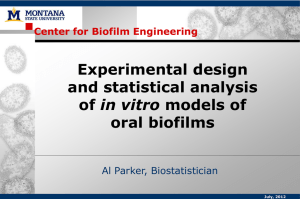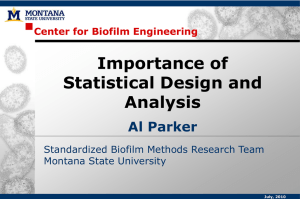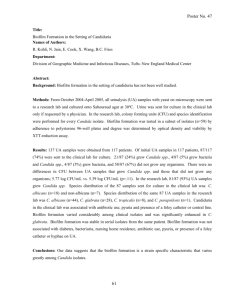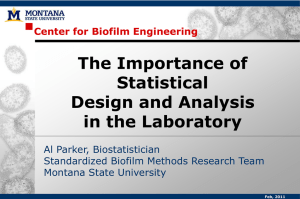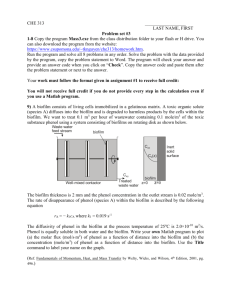Statistical methods for analyzing research data Center for Biofilm Engineering Al Parker, Biostatistician
advertisement
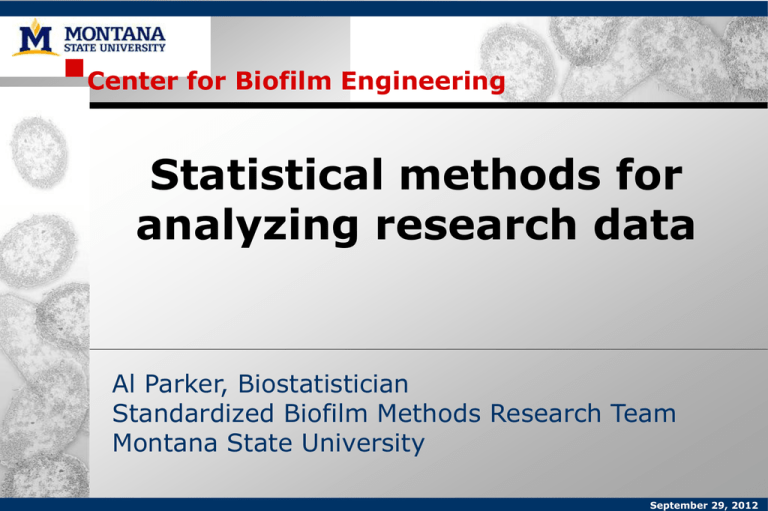
Center for Biofilm Engineering Statistical methods for analyzing research data Al Parker, Biostatistician Standardized Biofilm Methods Research Team Montana State University September 29, 2012 Standardized Biofilm Methods Laboratory Darla Goeres Al Parker Marty Hamilton Lindsey Lorenz Paul Sturman Diane Walker Kelli BuckinghamMeyer What is statistical thinking? Data Experimental Design Estimation and variance assessment What is statistical thinking? Data (pixel intensity in an image? Number of phyla detected by a molecular method? Length of time to some event? Infected or not? CFUs from viable plate counts?) Experimental Design - controls (positive and/or negative?) - randomization - replication (How many repeats in each experiment? Number of experiments? technicians?) Estimation and variance assessment - What statistical model to use? - What summary statistics to report? Why statistical thinking? Anticipate criticism (design method and experiments accordingly) Provide convincing results Increase efficiency (establish statistical properties) (conduct the least number of experiments) Improve communication Why statistical thinking? Biofilm Methods Attributes of a Biofilm Method: Seven R’s Relevance Reasonableness Resemblance Repeatability (intra-laboratory) Responsiveness Ruggedness Reproducibility (inter-laboratory) Attributes of a Biofilm Research Method Relevance Reasonableness Resemblance Repeatability (intra-laboratory) Responsiveness Ruggedness Reproducibility (inter-laboratory) Attributes of a Biofilm Research Method Relevance Reasonableness Resemblance Repeatability (intra-laboratory) Responsiveness Ruggedness Reproducibility (inter-laboratory) Relevance A standard laboratory method is said to be relevant to a real-world scenario if, given the same inputs, the laboratory outcome is predictive of the real-world outcome. Elbow Prosthesis - in vivo study Urinary catheter in vivo study Urinary Catheter Biofilm CV Catheter in vivo study Biofilm in the Catheter Tip 1,000 X magnification Sheep (control) Attributes of a Biofilm Research Method Relevance Reasonableness Resemblance Repeatability (intra-laboratory) Responsiveness Ruggedness Reproducibility (inter-laboratory) Resemblance Independent repeats of the same experiment in the same laboratory produce nearly the same control data, as indicated by a small repeatability standard deviation, CSr = STDEV(Mean Controls for each experiment) http://www.biofilm.montana.edu/content/ksa-sm-10 Resemblance Example Resemblance Example Data: log10(cfu) from viable plate counts Coupon 1 2 3 Density LD cfu / cm2 log(cfu/cm2) 5.5 x 106 6.74 6.6 x 106 6.82 8.7 x 106 6.94 Mean LD= 6.83 Resemblance Example Exp coupon LD 1 6.73849 1 6.82056 1 6.93816 2 6.56276 2 6.63957 2 6.64086 3 6.91564 3 6.74557 3 6.89758 Control LD SD 6.83240 0.10036 6.61440 0.04472 6.85293 0.09341 Resemblance from experiment to experiment Summary Statistics: 6.95 1. Mean ControlLD = 6.77 the best guess for the true mean control LD 2 loglog(cfu) 10 (cfu/cm ) 6.90 6.85 2. CSr = 0.1322, 6.80 6.75 the typical distance between the ControlLD for a single experiment and the true mean control LD 6.70 6.65 6.60 6.55 1 2 experiment 3 CSr = STDEV(6.83240, 6.61440, 6.85293) not STDEV(LDs) Resemblance from experiment to experiment 6.95 The variance CSr2 = 0.13222 can be partitioned: 2 loglog(cfu) 10 (cfu/cm ) 6.90 6.85 6.80 87% due to among experiment sources 6.75 6.70 13% due to within experiment sources 6.65 6.60 6.55 1 2 experiment 3 Variance partitioned by: 0.87 = AVG(control SDs2)/(nc x0.13222) 0.13 = 1 - 0.87 Convincing others that you can estimate true mean control LD with confidence 1. Start with your best guess: Mean ControlLD 2. Calculate the SE of Mean ControlLD, using: CSr = the repeatability SD m = number of experiments SE of Mean ControlLD = CSr / m 3. CI for the true mean control LD = Mean ControlLD ± tdf=m-1 x SE Convincing others that you can estimate true mean control LD with confidence 6.95 1. Mean ControlLD = 6.77 6.90 6.85 log(cfu) 6.80 6.75 6.70 6.65 6.60 6.55 1 2 3 experiment 2. SE of Mean ControlLD = CSr / m = 0.1322/ 3 = 0.0763 3. A 95% CI for true mean control LD = Mean ControlLD ± tdf=2 x SE = 6.77 ± 4.30 x 0.0763 = 6.77 ± 0.3284 = (6.44, 7.09) log10 (cfu/cm2) Convincing others that you can estimate true mean control LD with confidence We are 95% confident that the true mean of the control LDs is between 6.44 and 7.09 Resemblance from technician to technician Summary Statistics: 8.7 1. Mean LD = 8.42 the best guess for the true mean control LD log10log(cfu) (cfu/cm2) 8.6 8.5 2. CSr = 0.17 8.4 8.3 8.2 8.1 experiment Tech 1 2 1 3 1 2 2 3 the typical distance between the ControlLD for a single experiment for a single tech and the true mean control LD across multiple techs Resemblance from technician to technician 8.7 The variance CSr2 = 0.172 can be partitioned: log10log(cfu) (cfu/cm2) 8.6 39% due to technician sources 8.5 8.4 43% due to between experiment sources 8.3 8.2 18% due to within experiment sources 8.1 experiment Tech 1 2 1 3 1 2 2 3 Variance partitioned by ANOVA Attributes of a Biofilm Research Method Relevance Reasonableness Resemblance Repeatability (intra-laboratory) Responsiveness Ruggedness Reproducibility (inter-laboratory) Repeatability Independent repeats of the same experiment in the same laboratory produce nearly the same response, as indicated by a small repeatability standard deviation Sr = STDEV(Mean response for each experiment) http://www.biofilm.montana.edu/content/ksa-sm-10 Repeatability Example Data: log reduction (LR) LR = mean(control LDs) – mean(disinfected LDs) You should analyze LRs instead of the individual control and treated LDs because usually the controls and treated exhibit different variability, which violates the homogeneity of variance assumption of the ANOVA model. Repeatability Example Exp coupon LD 1 6.73849 1 6.82056 1 6.93816 2 6.56276 2 6.63957 2 6.64086 3 6.91564 3 6.74557 3 6.89758 Control LD SD 6.83240 0.10036 6.61440 0.04473 6.85293 0.09341 Repeatability Example Exp 1 1 1 log density control treated 6.73849 3.08115 6.82056 3.29326 6.93816 3.03196 Control LD Treated LD LR 6.83240 3.13546 3.69695 2 2 2 6.56276 6.63957 6.64086 2.92334 3.03488 3.21146 6.61440 3.05656 3.55784 3 3 3 6.91564 6.74557 6.89758 2.73748 2.66018 2.72651 6.85293 2.70805 4.14487 Mean LR = 3.80 Since there is no obvious pairing between the controls and treated coupons in each experiment, get 1 LR for each experiment Repeatability Example Summary Statistics: 4.2 1. Mean LR = 3.80 the best guess for the true mean LR 4.1 4.0 2. Sr = STDEV(LRs) = 0.3068 LR 3.9 3.8 3.7 3.6 3.5 1 2 experiment 3 the typical distance between the LR for a single experiment and the true mean LR Convincing others that you can estimate true mean LR with confidence 1. Start with your best guess: Mean LR 2. Calculate the SE of Mean LR, using: S2c = within-experiment variance of control coupon LD = AVG(control SDs2) S2d = within-experiment variance of treated coupon LD = AVG(treated SDs2) S2E = among-experiment variance of LR = S2r - [S2c / nc + S2d / nd] nc = number of control coupons per experiment nd = number of treated coupons per experiment m = number of experiments SE of mean LR = Sr / m = 2 Sc nc • m + 2 Sd nd • m + 3. CI for the true mean LR = Mean LR ± tdf=m-1 x SE 2 SE m Convincing others that you can estimate true mean LR with confidence 1. Mean LR = 3.80 2. Sc2 = AVERAGE(0.100362,0.044722,0.093412) = 0.00693 Sd2 = AVERAGE(0.138862,0.145282,0.041822) = 0.01405 SE2 = 0.30682 - [0.00693/3 + 0.01405/3] = 0.08711 nc = 3, nd = 3, m = 3 SE of mean LR = 0.3068 / 3 = 0.00693 3•3 3. 95% CI for true mean LR 0.01405 + + 3•3 0.08711 3 = 0.1771 = 3.80 ± 4.30 x 0.1771 = 3.80 ± 0.7616 = (3.04, 4.56) Convincing others that you can estimate true mean LR with confidence We are 95% confident that the true mean LR is between 3.04 and 4.56 The mean LR is statistically significantly larger than 3 ((p-value=0.0228) using an upper 1-sided t-test with df=2) How many coupons? experiments? margin of error= tm-1 x 0.3068/ m = tm-1 x no. control coupons (nc): no. treated coupons (nd): no. experiments (m) 2 3 4 6 10 100 .00693 nc • m + .01405 nd • m + 2 2 3 3 5 5 12 12 2.81 2.76 2.71 2.68 0.78 0.76 0.75 0.74 0.50 0.49 0.48 0.47 0.33 0.32 0.32 0.31 0.22 0.22 0.22 0.21 0.06 0.06 0.06 0.06 .08771 m Attributes of a Biofilm Research Method Relevance Reasonableness Resemblance Repeatability (intra-laboratory) Responsiveness Ruggedness Reproducibility (inter-laboratory) Responsiveness A method should be sensitive enough that it can detect important changes in parameters of interest. Statistical tool: mixed effects regression or ANOVA (e.g., repeated measures regression or ANOVA) Responsiveness Example to changes in treatment concentration 6 6 5 5 4 4 log reduction log reduction Responsiveness: 3 2 3 2 1 1 0 0 LR = -0.4513 + .9389*DisConc 0 1 2 3 4 DisConc 5 6 7 0 1 2 3 4 5 6 7 DisConc This dose-response curve can be simply (but not exactly) represented by a line Stat Model: repeated measures (within each experiment) regression with disinfectant concentration as the covariate Responsiveness Example Responsiveness: to different treatments Comparing mean LRs in side-by-tests Responsiveness: Medical Device 1 7 3 5 2 6 8 4 Mean LR 1.599 1.749 2.303 2.368 2.519 3.067 2.690 2.915 to different treatments P-values Medical Device Efficacy Significant Groups A A A A B B B B C C C C D D D D E E E F F F 7 3 5 2 6 8 4 1 7 3 5 2 6 0.9587 0.4307 0.2477 0.0154 0.0065 0.0002 0.0004 0.9994 0.8796 0.8835 0.0049 0.0001 0.0003 0.9950 0.2933 0.0550 0.0132 0.0018 1.000 0.0002 0.1401 0.0869 0.3297 0.1467 0.0193 1.000 0.9992 Comparing mean LRs in side-by-tests Stat Model: repeated measures (within each experiment) ANOVA with fixed effect due to type of medical device Summary Good experiments use controls, randomization where possible, and sufficient replication. Even though biofilms are complicated, it is feasible to develop biofilm methods that meet the “Seven R” criteria: - Assess Resemblance by repeatability SD of the controls. - Assess Repeatability by repeatability SD of the response of interest. Estimate parameters of interest and assess variance by reporting CIs. To reduce variance in estimates, invest effort in conducting more experiments instead of using more repeats in each experiment. For data analysis across multiple experiments, use mixed effects models (i.e., models that account for repeated measures from each experiment) For additional statistical resources for biofilm methods, check out: http://www.biofilm.montana.edu/category/documents/ksa-sm Any questions?
